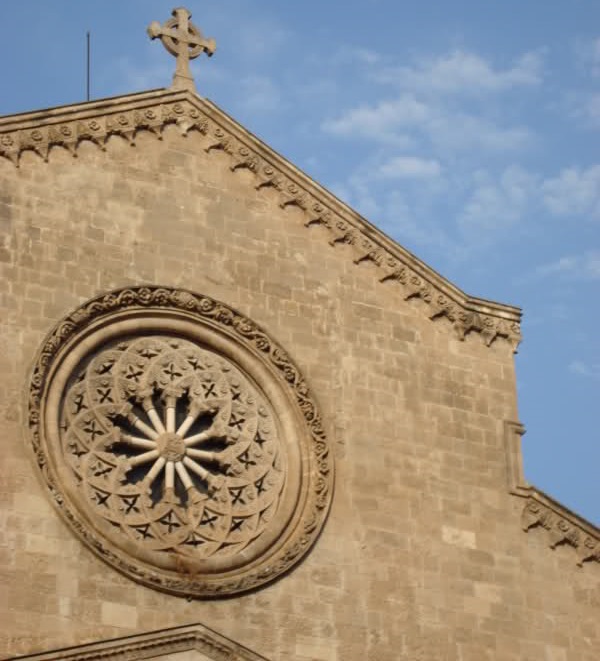
Read Italiano version
La chiesa di San Francesco dAssisi fu costruita nei primi decenni del tredicesimo secolo.
La prima struttura fu distrutta per volere dellImp. Federico II in odio alla Santa Chiesa che lo aveva da poco scomunicato. I frati ricostruirono la chiesa ed il convento nei trentanni successivi e nello stesso luogo che era stato acquistato dai frati ed era detto contrada della torre di Maniace.
La chiesa è a tre navate molto ampie, con un meraviglioso soffitto a capriate decorate e sostenute da colonne ed archi ricoperti in parte da affreschi. Il presbiterio triabsidato ha il cappellone centrale rettangolare con un coro in legno cinquecentesco ed un magnifico altare.
A destra del presbiterio si trova la Cappella dellImmacolata Concezione, voluta e fatta decorare con marmi mischi senza soluzione di continuità, nel 1624, dal Senato di Palermo. Vi lavorarono i marmorari La Mattina, DAprile, e Travaglia con le loro maestranze; le statue dei compatroni di Palermo sono di G. B. Ragusa. Vito DAnna ha disegnato il mosaico con lImmacolata sopra laltare maggiore.
La chiesa nei secoli ha subito diverse trasformazioni causate da vari eventi, non ultimo la guerra.
Il soffitto ligneo, inizialmente, era stato coperto da volte a crociera e la chiesa era stata tutta ricoperta di stucchi da Giacomo Serpotta e daffreschi di vari autori, ma le bombe dellultima guerra hanno riportato alla luce le antiche strutture e con il restauro successivo sono venute fuori le varie trasformazioni.
Tra il XIII ed il XVIII secolo antiche famiglie patrizie costruirono le loro cappelle gentilizie a ridosso delle navate laterali e grandi maestranze di tutti i secoli ci lasciarono opere di insigne valore di scultura, architettura e pittura; basta ricordare la Cappella Mastrantonio e la Cappella Calvello, gli artisti, quali::Gagini, Laurana, Serpotta e Marabitti.
Addossate alle colonne della navata centrale su alti basamenti sono le statue delle Virtù di Giacomo Serpotta e sulla porta centrale un grande affresco di Pietro Novelli che rappresenta San Francesco e i Santi.
La facciata, definita nel suo disegno allinizio del XIV sec. che ci presenta un portale a triplice ghiera lievemente aggettante e fortemente decorato, termina in alto con un timpano triangolare che racchiude a sua volta una trifora cieca ricoperta da pitture coeve sovrastata a sua volta da un maghifico e ricco rosone.
Il Convento costruito nel XIII sec. è di enormi dimensioni, si articola su due grandi cortili ed occupa una vasta area.
Al suo interno vi sono diverse cappelle e vari oratori appartenuti a Congregazioni e Compagnie non più esistenti, ma anche locali, scaloni, sacrestie, sarcofagi, suppellettili e decorazioni interessanti. Degna di menzione è la Cappella del Porto e Riporto della omonima Congregazione, che è stata edificata dalla famiglia Sclafani nel XIV sec.. Anche il convento è stato distrutto dagli ultimi bombardamenti ed è stato in parte ricostruito.
-
Indirizzo: Piazza San Francesco d’Assisi
- Orari visite :Da mar a ven (Tue to Fri) h 09.00am/11.00am 4.00pm/5.00pm. Messe Lun/sab (Services Mon/ Sat) 08.00 e 17.30. Dom. (Sun) 08.00 10.00 12.00- 05.30pm
- Contatti: tel. 091 58 23 70.
The church has three very large aisles with a wonderful truss ceiling which is decorated and supported by columns and arches partly covered by frescoes.
The presbytery with three apses has a large rectangular central chapel with a sixteenth-century wooden choir and a magnificent altar.
On the right of the presbitery is the Chapel of the Immaculate Conception, which was decorated with seamless “mischi” marbles by the Senate of Palermo in 1624.Some marble workers used to work there: La Mattina, D’Aprile and Travaglia were some of them who were with their helpers;The statues of Palermo’s patrons are by G. B. Ragusa. Vito D’Anna designed the mosaic with the Immaculate on the high altar.
The church over the centuries has undergone lots of changes caused by various events, the war was among these
The wooden ceiling was initially covered by cross vaults and the church had been covered with stuccoes by Giacomo Serpotta and frescoes by various artists, afterwards the bombs of the last war brought to light the old structures and by the following restoration many transformations came to light.
Between the 13th and the 18th centuries, ancient noble families built their aristocratic chapels close to the side aisles so great craftsmen of all ages left interesting works of outstanding value in sculpture, architecture and painting. It is worth mentioning the Cappella Mastrantonio and the Calvello Chapel and worth recalling some artists such as Gagini, Laurana, Serpotta and Marabitti.
Close to the columns of the central nave on high pedestals are the statues of the Virtues by Giacomo Serpotta and the central door hosts a great fresco by Pietro Novelli representing San Francesco and the Saints.
The facade, whose drawing was completely designed at the beginning of the 14th century displays a portal with a slightly protruding and strongly decorated triple arched lintel; at the top a triangular tympanum, which encloses a blind trifora three mullioned window – it is covered with the paintings of that time and surmounted by a maghificent and rich Romanesque rose window.
The Convent which was built in the 13th century is enormous, it was erected on two large courtyards and occupies a vast area.
Inside there are several chapels and various oratories belonging to congregations and non-existent “Compagnie” , locals, staircases, sacristies, sarcophagi, ornaments and interesting decorations. It is worth mentioning the Chapel of the “Port and Portion” of the homonymous Congregation, which was built by the Sclafani family in the 14th century. The monastery was also destroyed by the last bombardments and was partially rebuilt.
- Address: Piazza San Francesco d’Assisi
- Visiting times: Tue to Fri h 09.00am/11.00am 4.00pm/5.00pm. Services Mon/ Sat 08.00 e 17.30. Sun 08.00 10.00 12.00- 05.30pm visits not allowed during Services;
- Contacts: tel. 091 58 23 70.
